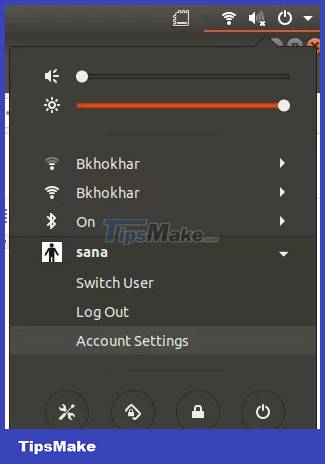How to assign admin rights to users in Ubuntu
The commands and processes mentioned in this article are performed on Ubuntu 20.04 and Ubuntu 22.04 systems.
Make user admin in Ubuntu via GUI
To change user settings through the user interface, you need to open the Users tab in the System Settings utility . You can access it through the following two ways:
Enter the keyword users into the system Dash and click on the Users search result.

Or
Click the down arrow located in the upper right corner of the Ubuntu screen, click your username in the following view, and then click Account Settings from the drop-down menu.

The Settings utility will open, displaying the Users tab. Please note that only authorized users can change user settings in Ubuntu. First, you need to unlock the tab to make changes as an admin by clicking the Unlock button located at the top right corner of the Users view:

This will open the following Authentication dialog , where you can provide the password for the authorized user:

Enter the password and then click the Authentication button. You can now change any user's settings. Click the username of the user you want to set as admin.

Under the user's Account Type, you'll see two buttons ; Standard button and Administrator button. Click the Administrator button to set this user to admin. As soon as you do this, the user will be granted admin rights and can now do all the operations that require root privileges.
Make user admin in Ubuntu via command line
The article will describe two ways to turn a standard Ubuntu user into an admin via the command line:
- Through the command usermod
- Via the gpasswd . command
We will use Ubuntu's command line application, Terminal, to do this. You can open Terminal via the system Dash or the keyboard shortcut Ctrl+Alt+T .
Method 1: Usermod . command
Open Terminal and enter the following command as sudo because only authorized users can edit user settings in Ubuntu:
Syntax:
$ sudo usermod -aG sudo 'username'This example will use the following command to set the user with the username 'sampleuser' as admin:
$ sudo usermod -aG sudo sampleuser
Enter the password for sudo and the user will be added to the 'sudo' group which means that the person can perform all administrative tasks on Ubuntu.
You can verify that the user is currently in the 'sudo' group by checking the groups the user belongs to, via the following command:
$ groups 'username'The following output of the groups command for "sampleuser" indicates that the user is now part of the sudo group.

Method 2: Command gpasswd
Open Terminal and enter the following gpasswd command as sudo because only authorized users can edit user settings in Ubuntu:
Syntax:
$ sudo gpasswd -a 'username' sudoThis example is adding 'sampleuser' to the sudo group via the following command:
$ sudo gpasswd -a sampleuser sudo
You can also remove a user from the sudo group via switch -r in the same gpasswd command:
Syntax:
$ sudo gpasswd -d 'username' sudoThis example is removing 'sampleuser' from the sudo group via the following command:
$ sudo gpasswd -a sampleuser sudo
Through the methods described in this article, you can turn a normal Ubuntu user into an admin so that they can perform all the tasks that require root privileges on the system.
You should read it
- Losing Admin permissions on Windows 10 / 8.1, this is a fix
- What is Admin? Admin Facebook, what is the website?
- How to set up always opening applications with admin rights on Windows 11
- How to assign Administrator permissions on a Windows 7 computer?
- How to grant Admin rights to a User in Win 10
- How to open Notepad with admin rights
 5 things to do when installing Ubuntu on PC
5 things to do when installing Ubuntu on PC How to Install Visual Studio Code on Arch Linux
How to Install Visual Studio Code on Arch Linux 7 Enterprise Linux Server Distributions
7 Enterprise Linux Server Distributions How to Install and Setup Snort IDS for Linux Network Security
How to Install and Setup Snort IDS for Linux Network Security Everything you need to know about using Nala on Ubuntu
Everything you need to know about using Nala on Ubuntu Difference between which, whereis and whatis in Linux
Difference between which, whereis and whatis in Linux